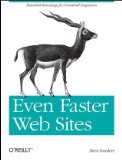 Building high performing front ends to websites is often an after thought. This is especially true if you look at Drupal sites and even the high end of Drupal sites. I just finished reading Even Faster Web Sites: Performance Best Practices for Web Developers, a book by Steve Souders the original author of YSlow, author of High Performance Websites, and a Google Engineer. This book directly deals with making sites fast.
Building high performing front ends to websites is often an after thought. This is especially true if you look at Drupal sites and even the high end of Drupal sites. I just finished reading Even Faster Web Sites: Performance Best Practices for Web Developers, a book by Steve Souders the original author of YSlow, author of High Performance Websites, and a Google Engineer. This book directly deals with making sites fast.
Over the past few years I’ve read a lot about making websites fast. Most of what I’ve read and heard dealt with making the servers run fast by using reverse proxies, better server caching system, CDNs, and other server side elements. But, the performance websites users experience is based on a lot more than these. And, because most web developers build sites locally or sit on the highest speed of internet connections they don’t experience what most of the world does with websites. This other side of performance that can have a large impact on end users is what Even Faster Web Sites addresses.
How Browsers Work
If you want to make a front end perform you need to know how browsers work. They often do things that are not all that intuitive (sometimes because they are following some sort of specification) or in a way we just don't realize. The book addresses a lot of these and talks about best practices to work with browsers to make them fast.A simple example of this can be seen in how browsers download resources (images, media, CSS, etc.). There are specific patterns and knowing these mean we can optimize how these are served to make them noticeably faster.